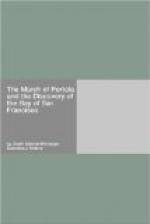[4] Vizcaino says he set out on the discovery of the coast of the South Sea with two ships, a lancha, and a barcoluengo. A lancha was a small vessel having no deck and but one mast, and propelled by sweeps. Vanegas calls the vessel a fragata. A barcoluengo, or barcolongo, was a long open boat.
[5] The second voyage of Vizcaino is of particular interest to Californians for the reason that the names given by him to the various geographical features of the coast still remain. The particulars of the first voyage are taken largely from the publications of the Southern California Historical Society of documents in the Sutro collection.
[6] Sutro Col. Pub. Southern California Hist. Socy.
[7] Prof. George Davidson identifies the Rio de los Reyes as Rogue River in 42deg. 25’.
[8] About Cape San Quintin, the latitude of their northernmost mission.
[9] Instruccion qua ha de observer el Teniente de Infanteria. Dn Pedro Pages, 5 enero de 1769. Provincial State Papers; i, 38.9, Ms. Spanish Archives of California.
[10] So-called from the cuera, a leathern jacket worn by them as a defensive armor.
[11] Out West. March-July, 1902.
[12] Pancakes.
[13] Dead Men’s Point. The name has disappeared from the modern maps, but is found on all of the old ones. It is the foot of H street where the cars for the Coronado ferry turn on to the wharf.
[14] I am well aware that this claim will be disputed by one whose study of original documents and power of analysis make him perhaps the greatest authority on early California History; but I am nevertheless prepared to maintain my position.
[15] Carga, 275 lbs.
[16] Hence the presidial soldiers were called Soldados de Cuera and so distinguished from soldiers of the regular army.
[17] Diario Historico de los viages de Mar y de tierra hichos al norte de la California. Ms. Original in Sutro Library.
[18] The league is the Spanish league of 5,000 varas. 2.63 miles.
[19] They also gave it the name of Santa Ana, whose day, July 26th, they had just observed.
[20] Sometimes called the Grand Pardon of Assisi — the great indulgence of the Franciscans. Originally granted to St. Francis for the Church of Our Lady of the Angeles of Porciuncula, it was, by apostolic indult, expanded to accompany the child of St. Francis wherever he may be. It is enough for him to erect an altar and that altar will be to him St. Mary of the Angels, and he will there find the Porciuncula of the revelations. Whoso confesses and receives the sacrament in the church of Porciuncula is granted plenary remission of his sins in this world and the next. This indulgence is only for August 2nd — that is, from the afternoon of August 1st until sunset of August 2nd.
[21] It is to this incident that the city of Los Angeles owes its name. The full baptismal name of the city is Nuestra Senora La Reina de los Angeles — Our Lady the Queen of the Angels. It was founded in 1781, by royal order, the second pueblo established in California.




